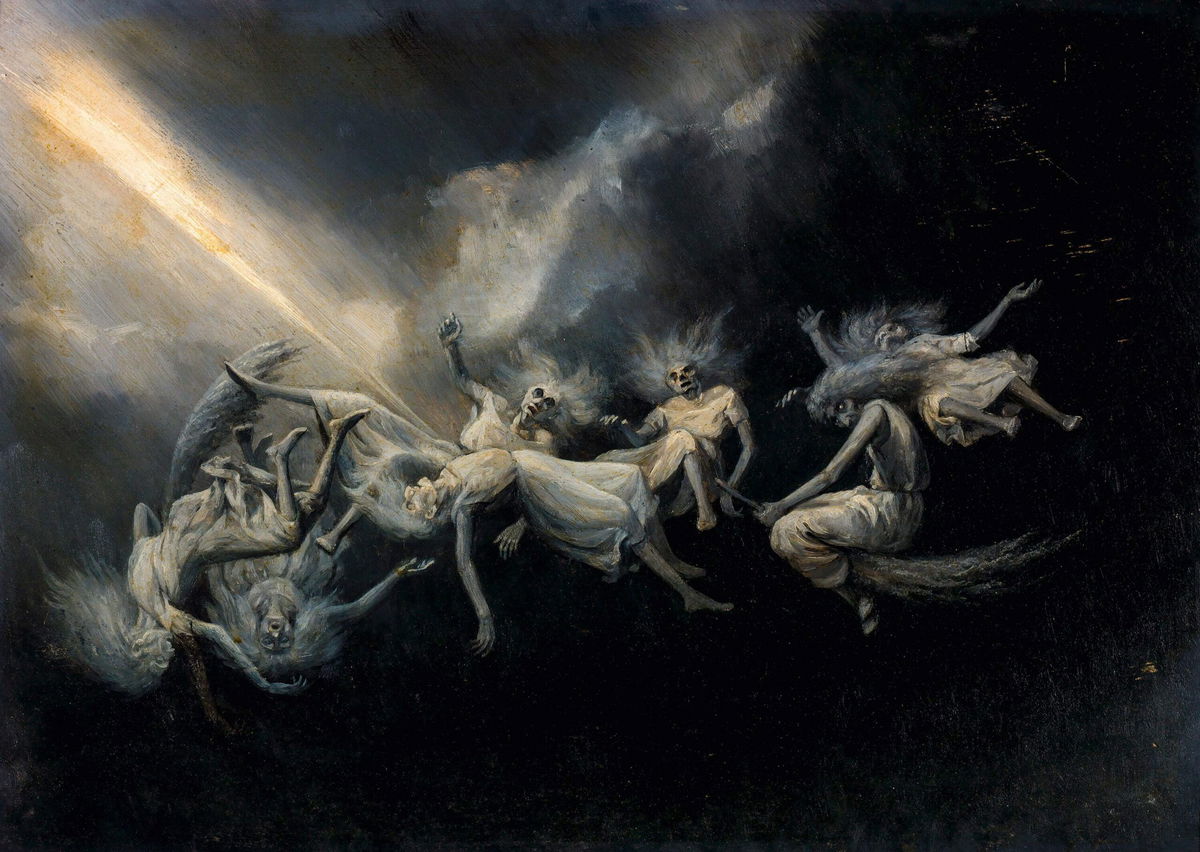The witch isn’t dead: New book explores witchcraft’s rebellious history — and modern transformation

Marianna Cerini, CNN
Look up “witches” and you might see any of a number of depictions: ugly old ladies and young, sensual temptresses; antiheroes and aspiring role models; evil creatures mixing deadly potions and righteous sorceresses helping girls find their way (a la Glinda the Good Witch in “The Wizard of Oz”).
A new title from Taschen’s Library of Esoterica aims to explore this wealth of complex identities in a visually vibrant volume that isn’t so much a book as it is a spellbinding tribute to a figure and a practice that are as old as time.
“Witchcraft” offers a deep dive into the many facets of a centuries-old tradition in the Western world, weaving more than 400 classic and contemporary artworks with essays and interviews by what editor Jessica Hundley describes as “a diverse coven of writers, scholars and modern-day practitioners, each embracing the practice in their own individual ways.”
“I wanted to present witchcraft through symbolism and art but also fresh, personal perspectives,” Hundley explained in a phone interview. “So much of the esoteric is often shrouded in secrecy and weighed down by stigma. With ‘Witchcraft,’ we worked collaboratively on introducing the subject in a way that felt inclusive and less intimidating.”
Clocking in at 500-plus pages, the compendium spans the history of witchcraft and the representation of witches in literature and fairy tales; the tools of the craft and the rituals that have long been part of it. There are also sections dedicated to fashion, creative media and the witch in films and pop culture.
A history of feminine energy and rebellion
While the word “witch” has its etymological roots (wicce) in Old English, the lineage of the ‘Western witch’ can be traced back to Greek mythology and the earliest folk traditions of Egypt, northern Europe and the Celts.
Each culture represented the mystical figure differently, yet some of her traits recurred across geographically widespread countries: a witch was a powerful goddess, often associated with home and love, but also death and magic. Above all, she was a signifier of complex femininity.
“The iconography of the witch, while shifting over the centuries, has always revolved around the idea of feminine power, and reflected society’s changing attitudes towards it,” said the book’s co-editor, Pam Grossman, in a phone interview.
In the 11th century, as male-centered Christianity spread across Europe, perceptions of femininity changed.
So-called witches (often any woman who strayed from the prescriptions of monotheistic religion) began to be considered outliers within their communities, feared and isolated for their supposed connection with the devil.
By the 14th century, the collective imagination had recast witches into heretical outcasts. For the next three centuries, witch hunts and executions — including the Salem trials of 1692 — would sweep both the Old and New Worlds.
“The image of the witch that’s been crystallized in our minds — that of a diabolical, frightening woman — was born out of this exact period,” said Grossman, who is also a writer, curator and teacher of magical practice. “The advent of the printing press, in particular, really helped popularize it. What she really was, of course, was even scarier: a threatening woman.”
Indeed, what emerges from “Witchcraft” is that witches and their practice have long been a metaphor for women who want authority over their own lives (the coven, essentially a female-run community, is part of this metaphor, too). Browsing the book, which features works by names as diverse as Auguste Rodin, Paul Klee and Kiki Smith, it’s hard not to notice how so many of them represented witches as fierce, powerful creatures even as they were being shunned by society.
Whether aging hags or hypersexual young beauties, they’re the embodiment of a rebellious spirit that “wants to subvert the status quo,” Grossman said.
A resurgence of witches
In the 18th and early 19th century, as the persecution of witches ended (at least in the Western world) and witchcraft started to be recognized as the last vestige of pagan worship, the magical figure was recast once again. This time, she was made into a fantastical subject as well as a symbol of female rage, independence, freedom and feminism.
Behind the latter “rebranding” was the suffragette movement, which used the archetype of the witch as the persecuted “other,” an example of patriarchal oppression.
Witchcraft gained popularity again in the 1960s as second-wave feminism saw witches and their covens as expressions of feminine power and matriarchy (on the activism side, there was even a group of women who, in 1968, founded an organization called W.I.T.C.H).
The practice made another comeback during the 1990s, following the Anita Hill hearings and the rise of third-wave feminism; and then again in the wake of Donald Trump’s 2016 election and the #MeToo movement.
Over the past four years, the practice has gone mainstream, spurring articles, podcasts and Instagram accounts.
“I think that for a lot of women and, increasingly, queer and nonbinary people, the witch has come to represent an alternative to institutional power, as well as a way to tap into their spirituality in a way that isn’t mediated by someone else,” Grossman said.
“Witchcraft is a means by which you can feel like you have some agency in the world. And because so much of it is about creating your own rituals, it allows individuals from different backgrounds to take part in it on their own terms.”
The witchy narrative has evolved on screen, too, and “Witchcraft” dedicates its last pages to that.
From the scary Wicked Witch of the West in “The Wizard of Oz” to the beautiful Samantha of “Bewitched” and the tenacious Sabrina of the “Chilling Adventures of Sabrina” (which couldn’t be more far removed from the original show starring Melissa Joan Hart), the witch has shifted from villain to protagonist, and from someone you would be afraid of to someone you might aspire to be.
“Whether they instill fear, seduce, use violence or act for the greater good, the way visual arts portray witches is always reflective of the cultural moment they’re part of,” Hundley said. What has remained unchanged through the centuries, she noted, is that the very nature of the witch is to contain all of these archetypes within her at all times.
“The witch is in a state of constant evolution,” she said. “She’s a shapeshifter.”
“Witchcraft” is available in Europe now and will be released next month in the US.
Add to queue: Empowering witches
READ: “The Once and Future Witches” (2020)
Witchcraft and activism are woven together in this Gothic fantasy novel by Alix E. Harrow, set in an alternate America where witches once existed but no longer do The year is 1893, and the estranged Eastwood sisters — James Juniper, Agnes Amaranth and Beatrice Belladonna — join the suffragists of New Salem while beginning to awaken their own magic, transforming the women’s movement into the witches’ movement.
BROWSE: “Major Arcana: Portraits of Witches in America” (2020)
Frances F. Denny’s photographic project “Major Arcana: Witches in America” is an ambitious visual document of the modern face of witchcraft. Denny spent three years meeting and photographing a diverse group of witches around the US, capturing the various ways “witch-ness” expresses itself.
WATCH: “Motherland: Fort Salem” (2020)
Witches become superheroes in this action-packed series, currently in its second season. Three young sorceresses conscripted into the US Army — Raelle Collar, Abigail Bellweather and Tally Craven — use their supernatural tactics and spells to defend the country against a terrorist organization known as the Spree, a witch resistance group.
LISTEN: “Between the Worlds” (2018-present)
Host Amanda Yates Garcia discusses tarot, psychology, mythology, pop culture, witchcraft, magic, art and history alongside a series of special guests, in a podcast that aims to explore the many expressions of the practice.
WATCH: “American Horror Story: Coven” (2013)
Set in post-Hurricane Katrina New Orleans, the third season of the FX horror anthology series “American Horror Story” centers on a coven of witches descended from the survivors of the Salem trials as they fight for survival against the outside world. The show deals with femininity and race, as well as issues around modern feminist theories and practice.
Top image: Titled “Ritual,” this 2019 work by photographer Psyché Ophiuchus shows a ceremonial circle taking place in Fairy Glen on the Isle of Skye at dusk.
The-CNN-Wire
™ & © 2021 Cable News Network, Inc., a WarnerMedia Company. All rights reserved.

